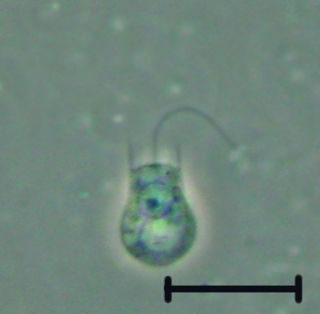
The choanoflagellates are a group of free-living unicellular and colonial flagellate eukaryotes considered to be the closest living relatives of the animals. Choanoflagellates are collared flagellates, having a funnel shaped collar of interconnected microvilli at the base of a flagellum. Choanoflagellates are capable of both asexual and sexual reproduction. They have a distinctive cell morphology characterized by an ovoid or spherical cell body 3–10 µm in diameter with a single apical flagellum surrounded by a collar of 30–40 microvilli. Movement of the flagellum creates water currents that can propel free-swimming choanoflagellates through the water column and trap bacteria and detritus against the collar of microvilli, where these foodstuffs are engulfed. This feeding provides a critical link within the global carbon cycle, linking trophic levels. In addition to their critical ecological roles, choanoflagellates are of particular interest to evolutionary biologists studying the origins of multicellularity in animals. As the closest living relatives of animals, choanoflagellates serve as a useful model for reconstructions of the last unicellular ancestor of animals.

The opisthokonts are a broad group of eukaryotes, including both the animal and fungus kingdoms. The opisthokonts, previously called the "Fungi/Metazoa group", are generally recognized as a clade. Opisthokonts together with Apusomonadida and Breviata comprise the larger clade Obazoa.

The Apusozoa are a paraphyletic phylum of flagellate eukaryotes. They are usually around 5–20 μm in size, and occur in soils and aquatic habitats, where they feed on bacteria. They are grouped together based on the presence of an organic shell or theca under the dorsal surface of the cell.

Ancyromonas is a genus of basal Eukaryote consisting of heterotrophic flagellates.

Telonemia is a phylum of microscopic eukaryotes commonly known as telonemids. They are unicellular free-living flagellates with a unique combination of cell structures, including a highly complex cytoskeleton unseen in other eukaryotes.
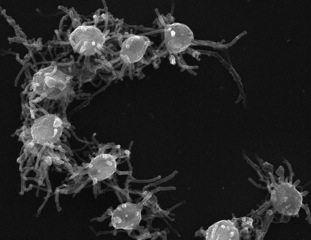
Capsaspora is a monotypic genus containing the single species Capsaspora owczarzaki. C. owczarzaki is a single-celled eukaryote that occupies a key phylogenetic position in our understanding of the origin of animal multicellularity, as one of the closest unicellular relatives to animals. It is, together with Ministeria vibrans, a member of the Filasterea clade. This amoeboid protist has been pivotal to unravel the nature of the unicellular ancestor of animals, which has been proved to be much more complex than previously thought.

Corallochytrium belongs to the class of Corallochytrea within Teretosporea and is a sister group to Ichthyosporea. Corallochytrium limacisporum is the only species of Corallochytrium known so far. It was first discovered and named in the Arabian Sea’s coral lagoons by Kaghu-Kumar in 1987. It was first thought to be a member of the fungi-like thraustochytrids, however, this was later disproven due to Corallochytriums lack of cilia and sagenogenetosome. Little research has been done on the life cycle or morphology. Most research concerning this genus has been done to uncover the evolution of animals and fungi, as Corallochytrium possess both animal and fungal enzymatic trademarks.

Filasterea is a proposed basal Filozoan clade of single-celled ameboid eukaryotes that includes Ministeria and Capsaspora. It is a sister clade to the Choanozoa in which the Choanoflagellatea and Animals appeared, originally proposed by Shalchian-Tabrizi et al. in 2008, based on a phylogenomic analysis with dozens of genes. Filasterea was found to be the sister-group to the clade composed of Metazoa and Choanoflagellata within the Opisthokonta, a finding that has been further corroborated with additional, more taxon-rich, phylogenetic analyses.

Holozoa is a clade of organisms that includes animals and their closest single-celled relatives, but excludes fungi and all other organisms. Together they amount to more than 1.5 million species of purely heterotrophic organisms, including around 300 unicellular species. It consists of various subgroups, namely Metazoa and the protists Choanoflagellata, Filasterea, Pluriformea and Ichthyosporea. Along with fungi and some other groups, Holozoa is part of the Opisthokonta, a supergroup of eukaryotes. Choanofila was previously used as the name for a group similar in composition to Holozoa, but its usage is discouraged now because it excludes animals and is therefore paraphyletic.

The apusomonads are a group of protozoan zooflagellates that glide on surfaces, and mostly consume prokaryotes. They are of particular evolutionary interest because they appear to be the sister group to the Opisthokonts, the clade that includes both animals and fungi. Together with the Breviatea, these form the Obazoa clade.
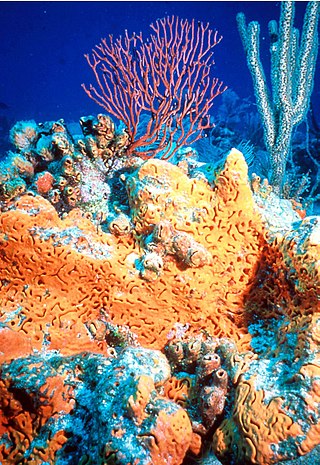
The Filozoa are a monophyletic grouping within the Opisthokonta. They include animals and their nearest unicellular relatives.

Holomycota or Nucletmycea are a basal Opisthokont clade as sister of the Holozoa. It consists of the Cristidiscoidea and the kingdom Fungi. The position of nucleariids, unicellular free-living phagotrophic amoebae, as the earliest lineage of Holomycota suggests that animals and fungi independently acquired complex multicellularity from a common unicellular ancestor and that the osmotrophic lifestyle was originated later in the divergence of this eukaryotic lineage. Opisthosporidians is a recently proposed taxonomic group that includes aphelids, Microsporidia and Cryptomycota, three groups of endoparasites.
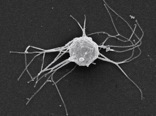
Ministeria is a genus of Filasterea. The species can be found in the North Atlantic Ocean and in British waters.

Creolimax fragrantissima is a single-celled protist that occupies a key phylogenetic position to understand the origin of animals. It was isolated from the digestive tract of some marine invertebrates, mainly from the peanut worm, collected from the Northeast Pacific.
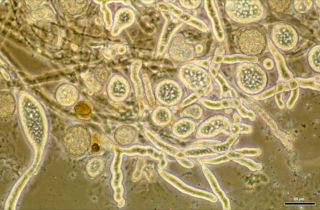
Ichthyophonus hoferi is a single-celled protist that occupies a key phylogenetic position to understand the origin of animals. It has chitin cell wall, hyphae, and an amoeboid stage. It is a common parasite of marine and freshwater fishes.
Mantamonads are a group of free-living heterotrophic flagellates that move primarily by gliding on surfaces. They are classified as one genus Mantamonas in the monotypic family Mantamonadidae, order Mantamonadida and class Glissodiscea. Previously, they were classified in Apusozoa as sister of the Apusmonadida on the basis of rRNA analyses. However, mantamonads are currently placed in CRuMs on the basis of phylogenomic analyses that identify their closest relatives as the Diphylleida and Rigifilida.

Parvularia atlantis is a filopodiated amoeba which was isolated from a lake in Atlanta and deposited in the American Type Culture Collection (ATCC) under the name Nuclearia sp. ATCC 50694 on 1997 by TK Sawyer. It was classified under the genus Nuclearia and morphologically resembles to Nuclearia species, although it is smaller. Later it was determined that it phylogenetically belongs to a new nucleariid lineage., distantly related to Nuclearia and Fonticula genera – the other two previously described nucleriid genera.
Mantamonas sphyraenae is a species of marine heterotrophic flagellates described in 2021. It belongs to the Mantamonadida, a basal eukaryotic lineage within a clade known as CRuMs. Its diploid genome is the first to be assembled within the CRuMs group.
Mantamonas vickermani is a species of marine heterotrophic flagellates described in 2021. It belongs to the Mantamonadida, a basal eukaryotic lineage within a clade known as CRuMs.

An amoeboflagellate is any eukaryotic organism capable of behaving as an amoeba and as a flagellate at some point during their life cycle. Amoeboflagellates present both pseudopodia and at least one flagellum, often simultaneously.
















